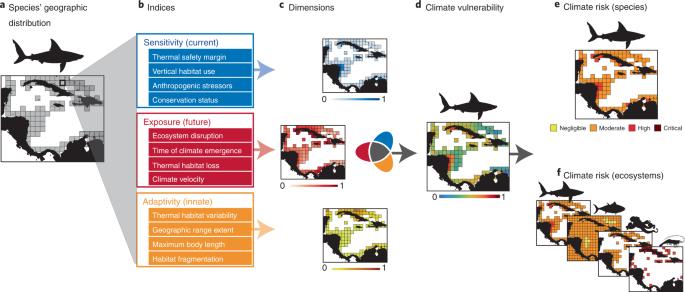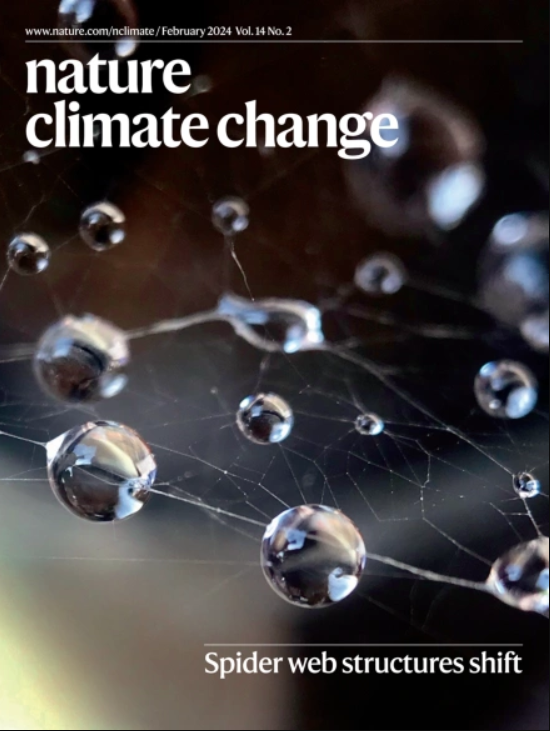海洋生物气候风险指数
IF 27.1
1区 地球科学
Q1 ENVIRONMENTAL SCIENCES
引用次数: 11
摘要
气候变化正在影响几乎所有的海洋生物。要制定适应战略,就必须充分了解物种和生态系统面临的风险,以及这些风险如何传播到人类社会。我们开发了一个统一的、空间明确的指数,以全面评估海洋生物面临的气候风险。在高排放条件下(SSP5-8.5),约 25,000 个物种中有近 90% 处于高风险或临界风险之中,其中 85% 的物种在其原生分布区面临风险。十分之一的海洋生态系统的气候风险、特有性和物种灭绝威胁都很高。气候变化对高度依赖渔业的低收入国家的已开发物种造成的风险最大。减缓排放(SSP1-2.6)可降低几乎所有物种的风险(98.2%),增强生态系统的稳定性,并使低收入国家粮食无保障的人口受益更多。我们的气候风险评估可帮助确定脆弱物种和生态系统的优先次序,以便开展适应气候的海洋保护和渔业管理工作。作者为两种排放情景下的海洋物种制定了气候风险指数,发现在高排放情景下,低收入国家的被开发物种面临的风险最大。减少排放可降低风险,增强生态系统的稳定性,并使依赖渔业的低收入国家受益。本文章由计算机程序翻译,如有差异,请以英文原文为准。

A climate risk index for marine life
Climate change is impacting virtually all marine life. Adaptation strategies will require a robust understanding of the risks to species and ecosystems and how those propagate to human societies. We develop a unified and spatially explicit index to comprehensively evaluate the climate risks to marine life. Under high emissions (SSP5-8.5), almost 90% of ~25,000 species are at high or critical risk, with species at risk across 85% of their native distributions. One tenth of the ocean contains ecosystems where the aggregated climate risk, endemism and extinction threat of their constituent species are high. Climate change poses the greatest risk for exploited species in low-income countries with a high dependence on fisheries. Mitigating emissions (SSP1-2.6) reduces the risk for virtually all species (98.2%), enhances ecosystem stability and disproportionately benefits food-insecure populations in low-income countries. Our climate risk assessment can help prioritize vulnerable species and ecosystems for climate-adapted marine conservation and fisheries management efforts. The authors develop a climate risk index for marine species under two emission scenarios and find that exploited species in low-income countries have the greatest risk under the high emissions scenario. Mitigating emissions reduces risks, enhances ecosystem stability and benefits low-income countries that depend on fisheries.
求助全文
通过发布文献求助,成功后即可免费获取论文全文。
去求助
来源期刊

Nature Climate Change
ENVIRONMENTAL SCIENCES-METEOROLOGY & ATMOSPHERIC SCIENCES
CiteScore
40.30
自引率
1.60%
发文量
267
审稿时长
4-8 weeks
期刊介绍:
Nature Climate Change is dedicated to addressing the scientific challenge of understanding Earth's changing climate and its societal implications. As a monthly journal, it publishes significant and cutting-edge research on the nature, causes, and impacts of global climate change, as well as its implications for the economy, policy, and the world at large.
The journal publishes original research spanning the natural and social sciences, synthesizing interdisciplinary research to provide a comprehensive understanding of climate change. It upholds the high standards set by all Nature-branded journals, ensuring top-tier original research through a fair and rigorous review process, broad readership access, high standards of copy editing and production, rapid publication, and independence from academic societies and other vested interests.
Nature Climate Change serves as a platform for discussion among experts, publishing opinion, analysis, and review articles. It also features Research Highlights to highlight important developments in the field and original reporting from renowned science journalists in the form of feature articles.
Topics covered in the journal include adaptation, atmospheric science, ecology, economics, energy, impacts and vulnerability, mitigation, oceanography, policy, sociology, and sustainability, among others.
 求助内容:
求助内容: 应助结果提醒方式:
应助结果提醒方式:


